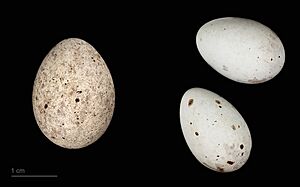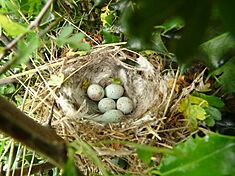European greenfinch facts for kids
Quick facts for kids European greenfinch |
|
|---|---|
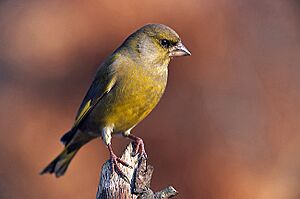 |
|
| Male | |
 |
|
| Female |
|
| Conservation status | |
| Scientific classification | |
| Genus: |
Chloris
|
| Species: |
chloris
|
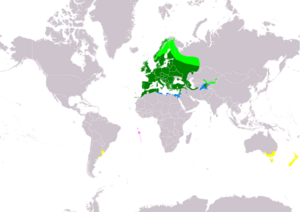 |
|
| Range of the European greenfinch (Chloris chloris) Breeding Resident Non-breeding Extant & Introduced (resident) Possible extinct & Introduced | |
| Synonyms | |
|
|
The European greenfinch (Chloris chloris) is a small, colorful passerine bird. It belongs to the finch family, called Fringillidae. These birds are known for their green feathers and bright yellow flashes on their wings and tail.
You can find European greenfinches across Europe, North Africa, and parts of Southwest Asia. Most of them stay in one place all year. However, some greenfinches from colder northern areas fly south for winter. People have also introduced these birds to countries like Australia, New Zealand, Uruguay, and Argentina.
Contents
Understanding Greenfinch Names
The European greenfinch got its scientific name, Loxia chloris, from Carl Linnaeus in 1758. He was a famous scientist who created the system for naming living things. The word chloris comes from an Ancient Greek word meaning "green," which perfectly describes this bird!
The Finch Family Tree
The finch family, Fringillidae, has many different types of birds. They are all seed-eaters and have strong, cone-shaped beaks perfect for cracking seeds.
The family is split into two main groups:
- The Carduelinae group has about 141 species.
- The Fringillinae group has only four species.
In all finch species, the female bird builds the nest. She also sits on the eggs to keep them warm and cares for the young chicks. Interestingly, finches in the Fringillinae group feed their babies mostly insects. But the Cardueline finches, like the greenfinch, feed their young a special mix of seeds they bring up from their stomachs.
A Change in Family Name
For a while, greenfinches were thought to be part of the Carduelis group. But in 2012, scientists used new methods to study their DNA. They found that greenfinches were not as closely related to other Carduelis birds as once thought.
Because of this, greenfinches were moved to their own group, called Chloris. This name was actually first used by a French scientist named Georges Cuvier way back in 1800!
Greenfinch Subspecies
There are 10 different types, or subspecies, of the European greenfinch. They look very similar but live in different parts of the world.
| Image | Name and describing authority | Where they live |
|---|---|---|
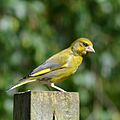 |
C. c. harrisoni Clancey, 1940 | Great Britain (except northern Scotland) and Ireland |
| C. c. chloris (Linnaeus, 1758) | Northern Scotland, northern and central France and Norway to western Siberia | |
| C. c. muehlei Parrot, 1905 | Serbia and Montenegro to Moldova, Bulgaria, and Greece | |
 |
C. c. aurantiiventris (Cabanis, 1851) | Southern Spain through southern Europe to western Greece |
| C. c. madaraszi Tschusi, 1911 | Corsica and Sardinia | |
| C. c. vanmarli Voous, 1952 | Northwestern Spain, Portugal and northwestern Morocco | |
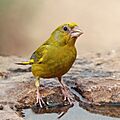 |
C. c. voousi (Roselaar, 1993) | Central Morocco and northern Algeria |
| C. c. chlorotica (Bonaparte, 1850) | South-central Turkey to northeastern Egypt | |
| C. c. bilkevitchi Zarudny, 1911 | Southern Ukraine, the Caucasus and northeastern Turkey to northern Iran and southwestern Turkmenistan | |
| C. c. turkestanica Zarudny, 1907 | Southern Kazakhstan to Kyrgyzstan and central Tajikistan |
What Does a Greenfinch Look Like?

The European greenfinch is about 15 centimeters (6 inches) long. Its wingspan, which is the distance from one wingtip to the other, is about 24.5 to 27.5 centimeters (9.6 to 10.8 inches). It's similar in size to a house sparrow.
Male greenfinches are mostly green with bright yellow on their wings and tail. Female greenfinches and young birds are a bit duller in color. They have more brown on their backs. All greenfinches have a thick, cone-shaped beak.
You can often hear a greenfinch's song, which is full of trilling sounds and wheezes. The male also has a special "butterfly" flight. He flies in a wavy pattern to show off during mating season.
Greenfinch Life and Habits
Reproduction and Life Cycle
Greenfinches usually start their breeding season in late March and continue until June. The young birds are ready to leave the nest by early July.
They like to build their nests in places with thick plants, like the edges of woodlands, farm hedges, and gardens. The female builds the nest, often with the male nearby. She usually lays 4 to 6 eggs, one each day. The eggs are greyish-white, bluish-white, or beige. They often have reddish or brownish spots, especially at the wider end.
The female sits on the eggs for about 13 to 14 days to keep them warm. During this time, the male brings her food at the nest. When the chicks hatch, they are covered in soft, greyish-white fuzz. For the first few days, both parents feed them insect larvae. Later, they feed the chicks a yellowish paste made from seeds.
The young greenfinches leave the nest when they are about 13 days old. They can't fly well yet, but they fledge (learn to fly) fully about 16 to 18 days after hatching. Greenfinches can have two or even three groups of babies each year. In places like Australia, their breeding season is from October to March.
What Do Greenfinches Eat?
European greenfinches eat a wide variety of foods. Their diet includes many different kinds of seeds, berries, fruits, and even flower buds. They also eat some small insects and other arthropods. They look for food both in trees and bushes, and on the ground.
Greenfinch Health Challenges
Greenfinches, like many animals, can get sick. A tiny parasite called Trichomonas gallinae usually infected pigeons and birds of prey. But starting in 2005, in Great Britain, many dead European greenfinches and common chaffinches were found to have this parasite.
This disease spread quickly. By 2008, it was found in Norway, Sweden, and Finland, and a year later in Germany. Scientists believe that common chaffinches helped spread the disease. This is because many chaffinches breed in northern Europe and spend their winters in Great Britain.
In Great Britain, the number of sick greenfinches found each year went down after 2006. However, the total number of European greenfinches dropped significantly. Their population went from about 4.3 million to around 2.8 million. This shows how much impact a disease can have on a bird species.
Greenfinches in Poetry
The famous English poet William Wordsworth wrote a poem about this bird. He called it The Green Linnet in 1803.



